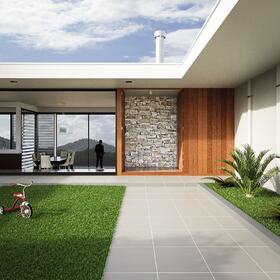
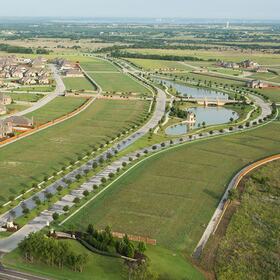
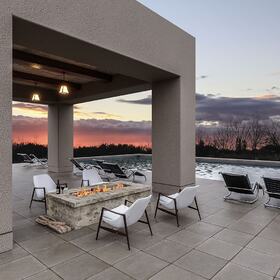
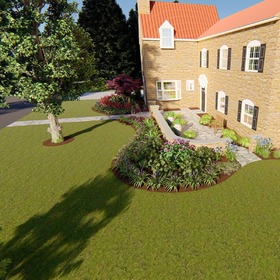
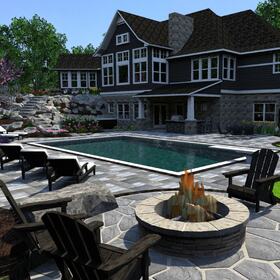
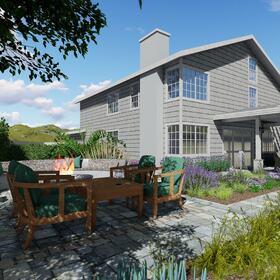






Many times, when the benefits of rendering are discussed, the focus is placed on product design and development of a tangible consumer product. From a more macro point of view, a product really can be so much more than that.
Take architecture, for example. What is the product? The building, of course, but there are more elements to it than that. Being able to have a preliminary vision of how a building design will look is an excellent application of advanced rendering capabilities, but what about the landscape itself?
On top of that, when looking at an architectural project as a whole, the landscape design is much more than just eye candy to captivate the viewer. It is a project and product all its own, and the same amount of care that went into the building design needs to be taken with the landscape design as well. In fact, a landscape design can actually be the entire scope of the project in the case of a property owner wanting to change or update the environment around an existing structure.
The same advances in technology that have benefitted product design and development can be used for the creation of an outdoor environment and landscapes as well, using 3D landscape rendering and visualization.
Similar to the impact of product rendering and visualization, the background of images used in a client presentation can have a significant effect on the perception of the overall product. The same can be said for the landscape renderings that an architect will use. A visually impressive building design may not pack as much punch for the client if the background is dull, lacks detail, and is boring.
Let’s take a look at precisely what 3D landscape rendering is and how it can ensure project success.
3D landscape rendering is simply a subset of rendering as a whole. As with product rendering, the overall procedure is defined as “...the automatic process of generating a photorealistic or non-photorealistic image from a 2D or 3D model by means of computer programs.”
For landscape purposes, the images used are generally meant to be as photorealistic as possible in order to convey the overall look of a landscape to a customer or client. Accurately rendered trees, shrubs, and grass are imperative, along with other aspects of nature that can affect the entire visual element of a site.
An aspect of landscape rendering that adds to the complexity is the fact that vegetation isn’t a set of surfaces that have any true pattern or function. A landscape is a set of irregular surfaces, and the fact that a computer model can reproduce it is a testament to how advanced rendering technology has become.
A 2D blueprint can only impart so much visual information. Which would you rather choose when previewing a design with a client – a flat image that lacks depth and perspective or a creatively designed 3D model of the project? The 3D landscape rendering will give a much more real sense of what the finished project will actually look like.
Landscape design has elements that may not be applicable when thinking in terms of traditional product development. For example, shading and shadows are important for an accurate representation of a consumer product, but they take on a whole new meaning when used in the context of visualizing a finished landscape. For example, imagine being able to see how the entire project will look during sunrise, or seeing how shadows will lay across a lawn at high noon.
A talented 3D landscape rendering freelancer can incorporate all sorts of design features into your images, such as details in the sky (types of clouds), or even representations of people.
3D landscape rendering can accurately be described as a prototyping tool. Landscape architects, once the underlying topography of a site is entered, can use the computer screen as a blank canvas to let their creativity flow – all without ever having to purchase a single tree or blade of grass.
Want to move that hill or change the number of shrubs over on the left side of the house right next to the garage? Want to see what a set of trees would look like next to that new office building? All it takes is a few mouse clicks to dramatically transform the look and feel of an entire site.
Being able to visualize an entire landscape environment has immense cost and time savings that, while relatively intangible, cannot be discounted. These factors are even more important when you are managing your own project – by working with a 3D landscape rendering firm, you can test out all of your ideas without spending a single dime on materials.
Property development isn’t a process that just happens. At some point, the developer may need to solicit outside investors. Visually stunning property renderings for a housing or commercial project will get the main point across, but being able to display a perfectly manicured landscape is the icing on the cake.
Just having a model to manipulate in 3D space is one thing, but imagine how a design could be visualized in the client’s mind if it was possible to take a virtual flythrough of the entire space? Many of the higher-end packages have that capability as well.
Having the ability to make changes on the fly saves time and money. Being able to visualize real-time changes presents a level of efficiency that could not be realized in the past. Let’s say that a client is adamant about having a line of maple trees on the south side of the property. You can easily lay them in, but then you notice that they just do not look right. They may cast shadows or let in too much light on that incredible deck wrapping the back of the house. So, what can you do? Simply change it!
The same can be said for color palettes for landscape design as well. Colors and various types of flowers and shrubs can be dropped in and changed at will to give the best representation of what the design will really entail – all without taking a single trip to the greenhouse or tree farm.
Architects typically don't get involved in designing landscapes – they usually focus their creativity and knowledge of design on the building itself. The responsibility for creating beautiful outdoor environments falls on landscape architects who are highly trained and creative individuals in their own right.
Interior designers know what colors and furniture designs will work best for a given room; similarly, landscape architects are masters of designing outdoor settings. Landscape architects tend to be much more specialized since they not only need to know about land and geology, but they must have a vast knowledge of the botanical sciences as well.
You can’t discount any of the do-it-yourself elements for the average homeowner, however. With the right software, a little bit of technical aptitude, and some creative inspiration, it’s entirely reasonable to create and manage your own design.
There are many software packages available on the market that will generate the rendering results that you’re looking for. Traditional software that has been used for mechanical design may have some of the features needed, but with the large amount of randomness that is inherent to an outside environment, you may be better off using a package that was specifically designed for landscape rendering work.
Some of the most prominent applications available include Lumion, Adobe Illustrator, Autodesk 3ds Max, and Rhino. There are low-cost and free options available as well, such as SketchUp, Lands Design, PRO Landscape Home, and Plan-a-Garden.
Similar to mechanical design software, each has pros and cons that may make a particular option more applicable to your project than another. It would be to your advantage to take the time to thoroughly research a package to ensure it would be a good fit for your needs before investing your time and money.
Gone are the days when a simple colored 2D blueprint is the only tool available for visualization of a complete landscaping project, no matter the size. From depicting backyard decks and patios to complete rolling landscapes, 3D landscape rendering has revolutionized the industry in a way that was never before thought possible.
Whether you’re an architect, general contractor, or just someone who wants to change the look and feel of an outside environment, there are situations where you may be better off hiring a 3D landscape rendering services company to do the hard work. That’s where the global and qualified community at Cad Crowd can help you achieve your goals. Get a free, no obligation quote, or even create a contest to get a multitude of ideas for your review. Contact us today!
Maybe you're designing a new model home, or you're in real estate and want to sell an up-and-coming development. A landscape visualization created by one of our 3D landscape rendering services firms could make the difference between closing a deal and going home empty-handed. In fact, allowing clients to visualize the property and landscape has proven to increase the rate of sales.
Whatever your reasoning for needing a 3D landscape rendering freelancer, let Cad Crowd's talented designers help. They're pre-vetted experts who are fluent in just about any software you could need. If you're interested, simply contact us for a free quote to get started.


